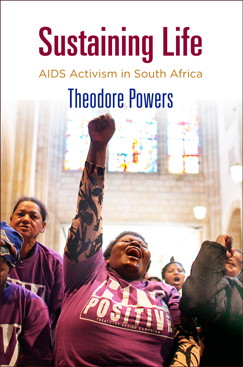Reviewed Book
Sustaining Life: AIDS Activism in South Africa. Theodore Powers, Philadelphia: University of Pennsylvania Press, 2020, 280 pp.

Christopher J. Colvin
University of Virginia
University of Cape Town
Although the AIDS activist movement in South Africa was one of the most important political developments in global health since the turn of the last century, we have few book-length ethnographic accounts of how this dramatic campaign for HIV treatment access played out in practice. This is surprising considering the central role that the fight for HIV treatment access in South Africa played in shaping the terrain of contemporary global health discourses, practices, and institutions. And it is a missed opportunity given the unique lessons and insights that the story of AIDS activism in South Africa offers medical anthropologists and others interested in the complex political and social dynamics of global health.
Theodore Powers’s new book, Sustaining Life: AIDS Activism in South Africa, provides an excellent introduction to anyone interested in knowing more about how South African AIDS activists—primarily those working as part of the Treatment Action Campaign (TAC)—developed its political campaign for demanding access to life-saving HIV treatment for all South Africans. His particular interest in this book is on the creative ways that TAC activists worked to “occupy the state” and transform state policymaking and policy implementing institutions from within. The book is based on multi-sited ethnographic research across a number of different scales and contexts, including national-level HIV policymaking institutions and processes, provincial department of health agencies overseeing implementation of new HIV policies and programs, as well as the day-to-day experiences of AIDS activists living and working in the Cape Town townships that were devastated by the epidemic.
The first two chapters provide a rapid but thorough introduction to the history of racial oppression and socioeconomic marginalization in colonial and apartheid-era South Africa. They also demonstrate how the high-profile AIDS activism of the mid-2000s was rooted in the political perspectives, strategies, and interpersonal networks that were part of apartheid-era progressive primary health care advocacy, human rights and gay rights campaigns, and the struggle for Black liberation.
Three ethnographic chapters follow, each examining a different scale and set of political actors and challenges that TAC confronted. The chapter on national policymaking shows how a critical policy institution—the South African National AIDS Council (SANAC)—was transformed through the work of TAC activists, from a body controlled by AIDS dissidents loyal to the then president and health minister to one where civil society actors, and the individuals and communities they represented, gained significant power and secured important policy wins for broadening HIV treatment access. The chapter on provincial-level policy translation and implementation shows how local NGOs working in coordination with state actors in the province can have an out-sized role in reshaping and redirecting national policy away from its intended goals. This chapter also provides an instructive example of how transnational donor capital can exert profound influence on policy implementation by bypassing national country coordinating mechanisms and working directly with provincial and local levels of the state. The final ethnographic chapter focuses on the ways national debates around AIDS denialism and treatment access were taken up, translated, and enacted at the local level. It highlights the powerful but much less visible impact of local governance structures like street committees and ward councils on how national policy priorities and provincial implementation plans actually unfold within local health services and communities. The book concludes with two chapters that reflect on the lessons South African AIDS activists offer for anthropological theories of the state and ethnographies of policymaking, and the limits of TAC’s human rights-based strategy when it comes to addressing the persistent social, political, and economic determinants of poor health in South Africa.
This book’s critical contribution is its focus on the day-to-day processes and dilemmas of HIV policy development and translation as it unfolded across multiple sites, scales, and contexts. Through a series of closely observed vignettes of TAC activists’ engagement with the state, Powers reveals the logic and craft of one of TAC’s most distinctive and important political strategies—its decision to work both within and outside of the state, combining street protests, civil disobedience, and judicial activism with direct, detailed, and sustained involvement in policy development and implementation.
The book concludes with a thoughtful reflection on life after TAC’s success in securing HIV treatment access. Powers points out that treatment access has not by any means translated into the “end of AIDS” in South Africa, and that the powerful structural forces and inequalities that made so many South Africans vulnerable to this epidemic persist. While Powers does gesture to the limits of TAC’s right-based approach in addressing these broader forces, there is perhaps a missed opportunity here to delve into and develop this critique in more depth. TAC’s success has been one of the most prominent and important successes in global health in recent decades, but it may also be the case that its political strategies—as novel and creative as they were—are not sufficient for addressing many of the ongoing problems global health advocates confront. A more thorough analysis of the promises and limitations of rights-based and state-engaged strategies for addressing the great global health challenges of our time would be useful. This book provides an excellent opening for just such a conversation. Sustaining Life is a very clearly and engagingly written book that would be accessible to most undergraduates, even those with limited knowledge about South African or AIDS activism. The book should be of interest to anyone working in medical anthropology, African studies, political science, development studies, and global health. It would be especially relevant reading for anyone trying to develop a richer understanding of how health policies are actually produced and in turn transformed by a wide range of actors—inside and outside of the state—as they are implemented.